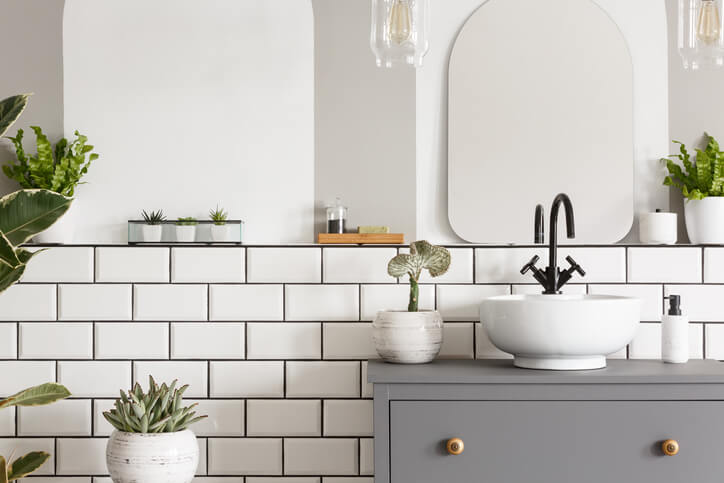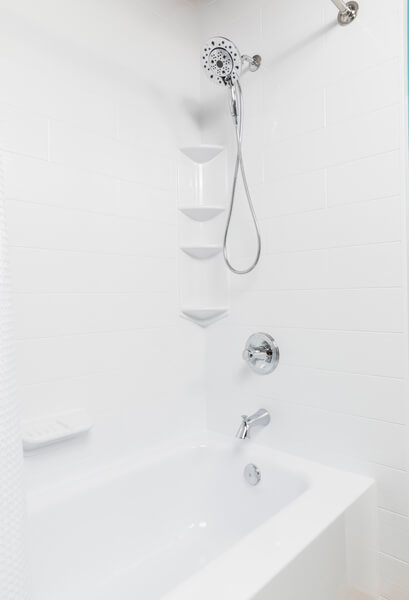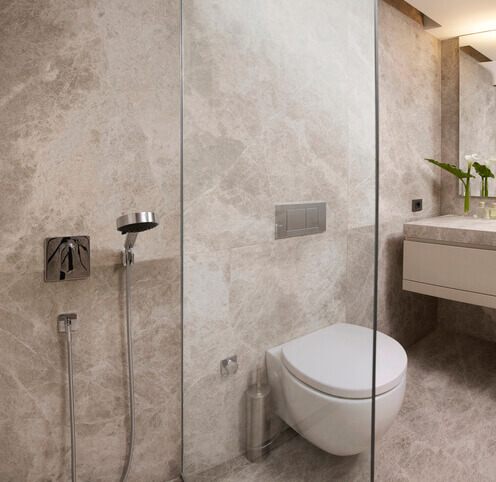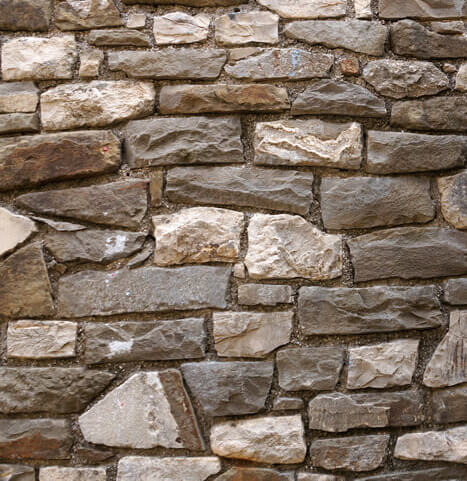You might not know it, but the modern version of the shower we enjoy today has only been around for the last century. That said, bathroom tiles and shower wall materials date back to ancient Greece and Rome.
Today, if you’re remodeling or renovating a bathroom, you will have thought about the best shower wall materials available and also possible shower tile alternatives. The range of shower wall alternatives today reflects every possible bathroom taste, from traditional to opulent. Let your choice of shower wall materials influence the look and feel that you want for your bathroom.
Read on to learn more about how to choose between some of the most common solid wall materials and tile alternatives for the bathroom you’ve always dreamed of.
What types of tile are available?
Each tile material has its own stand-out qualities and reasons why you may want to use it in your bathroom design. Newer tile materials like glass and stone can be used not only as a wall covering but as an integral design element. If you’re on a budget, ceramic tiling is a great solution.
- 1
Ceramic
The most common type of tile, ceramic has all the qualities needed: It’s strong, and it can create a modern, luxurious style for budget-conscious renovators. It’s suitable for both wall and floor tiles and is often used for both to create seamless patterns. Ceramic tiles come in both unglazed and glazed options. Use unglazed or matte tiles to add texture and as a design feature, while glazed or glossy tiles are good for longer protection and easy cleaning.
- 2
Porcelain
Similar to ceramic tiling in functionality, porcelain owns an extra level of refinement and elegance. Because porcelain is made using a mixture of finer clay, it has a harder, more durable surface and is more resistant to scratches and stains. It also absorbs less water than ceramic tiles. It costs more to produce porcelain tiles so, naturally, that will have to factor into your budget, but you might save over time due to porcelain’s long-term durability.
- 3
Glass
It’s often used to create colorful mosaics (backsplashes) and adds a feeling of lightness to the bathroom. It’s a hygienic material and can be cleaned using some soapy water or glass cleaner. Glass tiles have the added benefit of being eco-friendly, with many being made from recycled glass. Installation, however, is very tricky and requires professional help.
- 4
Stone
You can choose from a variety of stone tile alternatives, but remember that even though they look good, they need extra care and attention. Limestone is beautiful to look at and touch, and it creates the perfect rustic look. It does require proper sealing since it’s a porous material. Granite, which can be cheaper than other stone tiles, is a very heavy look and can be hard to install if you’re doing it yourself.
Why should I look for an alternative?!

If you have time and budget constraints, you should definitely look for some alternative wall materials and tiles for your bathroom. Choose the right solution and you could save hours on installation. Selecting a cheaper option might allow you to add extra design elements you couldn’t have afforded if you went with tiling. All tiles are prone to cracking and chipping, so perhaps you want something that will last a lifetime.
Maybe you’re just sick of cleaning grout. It’s the number one reason people choose an alternative to tiling. Not only does grouting require constant cleaning against mold buildup, it can lead to moisture getting in behind the wall, which creates a new problem.
There are a number of reasons to choose an alternative material over tiles. All you have to do is decide on which one.
Top 9 shower wall materials available today
We really are spoiled for choices these days when it comes to what to use for bathroom wall materials. No longer confined to a few options, new materials and manufacturing processes have presented bathroom designers with endless possibilities and unique design solutions.
Here are nine of the best new shower wall materials for your next project.
Acrylic panels

Simply put, acrylic panels have the look and style of tiles but without the mold, moisture, and cracking problems. A completely non-porous and waterproof material, it can be used to cover a full wall or as a decorative wainscoting wall accent.
Acrylic is one of the most cost-effective materials for your bathroom. Cheaper and with fewer problems than tiling, it can give you the look and functionality you’re after at a fraction of the cost. It is extremely durable, stain-resistant, and can resist scratching or chipping. Moreover, it’s easy to clean with a soft cloth and warm water.
Some acrylic panels are installed as separate pieces, which means you still need to worry about stopping moisture from becoming a problem and seal up your seams. The best solution, however, is to use the superior watertight, one-piece, seamless panel.
No more worrying about dirty grout or water damage in the walls. Acrylic paneling can now be custom designed and manufactured to fit the specific dimensions of your bathroom. Perfect for complete renovations or to freshen up your existing walls, it can even be installed over the top of your existing surface.
If you’re after a bathroom wall solution that will last a lifetime, your first choice should be seamless paneling. Less chance of leaky corners and seams means little chance of mold growth and water damage on or behind the panels.
PVC panels

Made from joining two sheets of PVC with a mesh structure between them, this bathroom wall material is a good option if you’re after something lightweight yet strong. It’s 100% waterproof since there are no seams. Never worry about leaks or dampness creating problems. Large areas of wall can easily and quickly be covered by large PVC panels in a variety of colors and styles. Often cheaper than tiles, its one drawback is susceptibility to scratches and cracks. Plus, if you have any damage, you will have to replace the whole panel.
Marble

The classic and elegant look of marble will never go out style. A timeless material with a unique look and no two pieces that look the same, marble is also surprisingly strong and will withstand repeated damage. If maintained and cared for correctly, marble can last a lifetime and is also 100% mold resistant.
As impressive as it is, marble has a few disadvantages. One of the big ones is its price tag. It can be quite expensive, and since it’s a finite material, it can also be hard to source. Marble needs to be regularly sealed as well since it’s prone to staining from acidic materials. It’s also very heavy and so may not be well-suited to some bathroom redesigns.
Stainless steel decorative panels
Stainless steel is used in every area of the modern house. It’s also used in the bathroom for a sharp, modern and clean alternative to tiling. A lightweight material that is easy to cut and shape to any size, stainless steel can double as a shower cubicle or a featured wall.
Resistant to a wide range of chemicals and requiring little maintenance, stainless steel does, however, have a few drawbacks. Seams need to be correctly caulked with silicone to prevent leaking and stop mold growth between and behind the panels.
Stone resin panels
Another option to create a seamless bathroom wall is to use stone resin wall panels. Made with a combination of acrylic resin, bauxite, epoxy, marble dust and pigments, stone resin is a solid and non-porous material that can be designed to look like natural stone and granite or classic marble.
Waterproof and stain resistant, stone resin is also incredibly strong and can withstand cracking and chipping. The surface is also warmer than tiling, so if you’re after a warm-to-the-touch feeling this might be the material for you. Stone resin is a very heavy material. You might find it hard to get in larger sizes. If your bathroom is a DIY project, then you may need to ask for help, since installation requires very heavy lifting.
Wood shower walls

Organic, natural and warm. As a bathroom wall material, wood has all these features and more. Used in saunas as a perfect material for humid conditions, wood can be cut to any shape or size your bathroom design requires. Different types of wood work better in bathroom conditions, so be sure to choose a type that can withstand heat and water splashes. Remember to seal the surface thoroughly. Warping may occur, which means that, although wood looks and feels fantastic, it will need regular upkeep and replacement.
Fiberglass
One of the least expensive options available for wall paneling, fiberglass can be molded to create unique designs if you’re looking for something custom made. Another solution that removes the problems of grouting and leaky seams, fiberglass can also be repaired inexpensively compared to other wall options. However, it is prone to scratching, and colors have been known to fade over time, which may require costly replacement of the entire panel.
If fiberglass becomes cracked, the porous material will become damaged due to excessive moisture. Although the initial cost of fiberglass is low, it can become a headache for you in the future, forcing you into costly repairs.
Paint
If you really want to be in control of your bathroom wall design, then let your artistic inspiration flow using the new generation of bathroom-ready wall paints. With the right preparation, you can apply almost any paint to a bathroom surface. Just remember to purchase mildew- or mold-resistant paints with antifungal additives.
Newer technologies add moisture and steam resistance. They’re easily washable paints and make for a good option. Keep in mind, however, that painting requires extra time for drying — usually between 3 to 5 days, and is susceptible to scratching, chipping, and peeling if not properly prepared.
Before painting, take extra care to remove any moisture that might get trapped behind the paint.
Natural stone

Stone is one of the most durable and naturally beautiful materials to use in a bathroom setting. It’s also the only material that looks better with age. Weathered stone as a feature is stunning to look at and is an invitation to touch. It’s slightly porous and has the ability to absorb soap and minerals from the water, so it needs to be sealed and maintained regularly. As with most unique materials, stone can be significantly more expensive than other alternatives and, due to its weight, may not be suitable for some bathrooms. Installation also requires professional, specialized skills.
What tile alternative to choose

When it comes to choosing a new shower wall, you will need to consider a number of factors. Not just the pros and cons of each material, but also questions like how much actual space you have to work with in the bathroom, whether you can work with your existing design or require a complete renovation, and also (and most important) your budget.
When using some materials, be prepared for regular maintenance and potentially expensive repairs. Mold, mildew, and water damage are common when seams are not sealed correctly. Maybe it’s best to go seam-free?
There’s no right answer to which shower wall material is best for your bathroom. Whatever you decide on, make sure you know the advantages and disadvantages of each material. A little bit of research can prevent having to choose again in a few years’ time.
